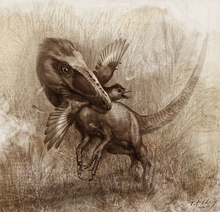Sinocalliopteryx
Sinocalliopteryx (meaning 'Chinese beautiful feather') is a genus of carnivorous compsognathid theropod dinosaurs from the Lower Cretaceous Yixian Formation of China (Jianshangou Beds, dating to 124.6 Ma).
While similar to the related Huaxiagnathus, Sinocalliopteryx were larger. The type specimen, at 2.37 meters (7.78 ft) in length, in 2007 was the largest known compsognathid exemplar. In 2012 an even larger specimen was reported.
The type species Sinocalliopteryx gigas was named and described in 2007 by Ji Shu'an, Ji Qiang, Lü Junchang and Yuan Chongxi. The generic name is derived from Sinae, Latin for the Chinese and Greek καλός, kalos, "beautiful", and πτέρυξ, pteryx, "feather". The large size of this "giant compsognathid" lent Sinocalliopteryx its specific name, gigas, meaning 'giant'.[1]
The holotype, JMP-V-05-8-01, was discovered at Hengdaozi, in Sihetun, in Liaoning Province, from the Jianshangou Beds of the Yixian Formation dating from the Barremian-Aptian, about 125 million years old. It consists of a nearly complete skeleton with skull, compressed on a single plate, of an adult individual. Extensive remains of protofeathers have been preserved.[1] In 2012 a second specimen was described, CAGS-IG-T1, of an individual larger than the holotype. The skull was about 10% longer, the feet about a third, a difference explained by positive allometry. The specimen consists of a partial skull, tail, hands, feet and ribcage. It shows filaments on the tail.[2]
Sinocalliopteryx was a bipedal predator. The preserved length of the holotype specimen is 237 centimetres. Its weight was estimated by Gregory S. Paul in 2010 at twenty kilogrammes.[3] Sinocalliopteryx is distinguished from Huaxiagnathus, as well as other compsognathids, by its relatively long hands in relation to its arms. The arms and hindlimbs were also longer overall than in other compsognathids, a feature possibly related to its size.[1]
Sinocalliopteryx had an elongated head with a pointed snout, showing a convex upper profile. There were four teeth in the premaxilla which were small but exceptionally had denticles on their front edges. Only six, larger, teeth were present in the maxilla of the holotype specimen but the number of its tooth positions could not be adequately determined. Specimen CAGS-IG-T1 preserves ten maxillary tooth sockets with room for one or two more in damaged areas. The jugal was a strongly built element with a high-rising front branch that formed part of the lower front edge of the eye socket. The lower jaw lacked an opening in its outer side.[1][2]





